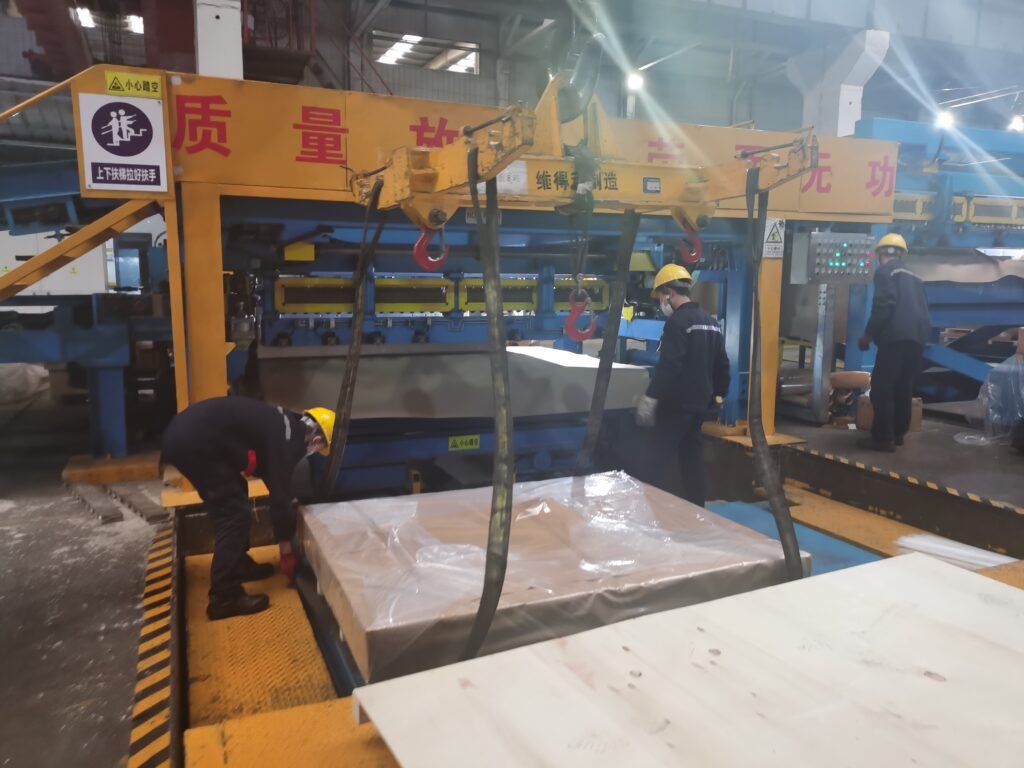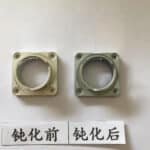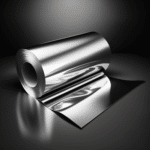Passivation refers to the process of treating metal surfaces with strong oxidants or electrochemical methods to transform them into a passive state, which is a method of converting metal surfaces into a less reactive state to slow down the corrosion rate of metals. In addition, passivation is a phenomenon in which the chemical reactivity of an active metal or alloy is significantly reduced, making it behave like a noble metal.
Passivation of metals occurs when the corrosion products generated by the action of the medium have a dense structure and form a thin film (often invisible) that tightly covers the metal surface. This changes the surface state of the metal, significantly shifting its electrode potential in the positive direction and turning it into a corrosion-resistant passive state. For example, the standard electrode potential of Fe→Fe2+ is -0.44V, but after passivation, it shifts to +0.5 to 1V, displaying corrosion-resistant noble metal properties. This thin film is called a passivation film.
Metal passivation can also occur as a spontaneous process, such as the formation of a insoluble compound (oxide film) on the metal surface. In industrial applications, passivating agents (mainly oxidants) are used to passivate metals and form a protective film.
Aluminum alloy passivation solution is a type of solution that can promptly form a strong and uniform passivation film on the surface of aluminum materials. It is suitable for corrosion protection of aluminum alloys and aluminum die-castings, forming a transparent and light-colored coating on the surface. It can also be used as a pre-treatment for spraying, powder coating, and adhesive application. This solution does not contain hexavalent chromium, is environmentally friendly, safe, non-toxic, easy to operate, and has low cost for user.
Characteristics of Aluminum Passivation Solution:
- Suitable for non-hexavalent chromium passivation of aluminum materials.
- Can be used as a post-treatment after anodizing.
- Concentrated solution based on trivalent chromium, with better corrosion resistance than hexavalent chromium passivation processes.
- Extremely long-lasting anti-salt spray rust resistance (according to ASTM B-117 and DIN EN ISO 9227 neutral salt spray testing standards, the appearance of initial white rust starts after 300 hours, but the corrosion resistance may vary due to different material characteristics).
- Easy to operate in immersion, spraying, and manual wiping processes.
- Forms a transparent and light-colored coating on the surface of the workpiece.
- Environmentally friendly, safe, non-toxic, easy to operate, and simple wastewater treatment.
- Suitable for passivation and corrosion protection of aluminum, aluminum alloys, and aluminum die-castings, as well as pre-treatment for spraying, powder coating, and adhesive application.
- Widely used in mobile communications, aerospace, automotive components, electrical and electronic equipment, waveguide devices, marine industry, construction industry, and other precision instruments for passivation and corrosion protection.
Process Flow:
The general passivation process for aluminum alloys includes the following steps: pre-degreasing, main degreasing, water rinsing, water rinsing, etching and descaling, ultrasonic degreasing rinsing, water rinsing, activation, water rinsing, water rinsing, passivation, water rinsing, water rinsing, and drying.
This is a relatively complete process flow, but each company can adjust it according to their actual on-site conditions and product quality requirements. It is not necessary to strictly follow the same process for every case. For example, if the workpiece has undergone mechanical polishing, the following simplified process can be used: degreasing, water rinsing, water rinsing, activation, water rinsing, water rinsing, passivation, water rinsing, water rinsing, and drying. If the workpiece has been mechanically polished and requires a natural color film with low corrosion resistance (such as a neutral salt spray test requirement of approximately 48-72 hours), the process can be further simplified to: degreasing, water rinsing, water rinsing, passivation, water rinsing, water rinsing, and drying. Based on these, if the workpiece has good water drainage, simple structure, the process can be further streamlined to: degreasing, water rinsing, passivation, water rinsing, and drying. Therefore, the determination of the process flow is related to product quality, efficiency, and cost, and must be analyzed based on specific requirements and the company’s product requirements.
What Makes a Good Cleaning Agent:
The quality of a cleaning agent is measured by three basic criteria:
- The aluminum alloy workpieces must not be corroded or discolored after cleaning. Some cleaning agents in the industry, in order to save costs, use strong inorganic acids and alkalis, which can cause “hydrogen embrittlement” on the metal surface, resulting in reduced mechanical properties of the workpiece material.
- Oil contamination, release agents, and other dirt must be thoroughly cleaned. Especially for non-polished aluminum die-castings, it is difficult to clean the release agents on the surface, and dedicated cleaning agents must be used for effective cleaning. To enhance the cleaning effect, specialized cleaning equipment such as ultrasonic cleaning is generally used in this step.
- The cleaning agent must meet the requirements of the cleaning equipment and local environmental regulations. For example, for spray cleaning, the cleaning agent must be low-foaming or non-foaming, and should have a low odor. Otherwise, it would not be suitable for spraying. If local environmental regulations have specific requirements, the cleaning agent must be selected without phosphates or heavy metals. Therefore, the selection of cleaning agents mainly depends on the surface condition of the workpiece, the equipment used, and environmental requirements.
Suitable Passivating Agents:
Currently, there are three types of passivating agents for aluminum alloys in the industry: hexavalent chromium passivating agents, trivalent chromium passivating agents, and chromium-free passivating agents.
Hexavalent chromium passivating agents are highly toxic and have significant hazards to humans and the environment. They have been gradually phased out by the industry. Trivalent chromium passivating agents are currently the most stable and effective passivating agents with minimal toxicity. As for chromium-free passivating agents, they are the trend of environmental protection in the country. However, a common issue with chromium-free passivating agents in the industry is that their corrosion resistance is not comparable to trivalent chromium passivating agents. The choice of passivating agent must be based on the corrosion resistance requirements of the product and environmental regulations.
Activation Agent:
In the passivation of aluminum alloys, the activation process promotes the formation of the conversion film. The selection of the activation agent depends on the passivating agent and the material. For example, phosphoric acid and phosphates are used as activation agents for carbon steel phosphating. For aluminum alloys, dilute nitric acid is generally used as an activation agent, and it is not recommended to use oxidizing or highly acidic acids such as sulfuric acid, hydrochloric acid, or phosphoric acid as activation agents. Dilute nitric acid has a slight corrosive and oxidative effect on aluminum alloys, which helps the formation of a chemically converted film.
Which type of water is good for dilution and rinsing agents?
The quality of water in the evaluation of the passivation process mainly revolves around the interference of ions in water with the formation and compactness of the conversion film during passivation. Water with a high concentration of impurity ions can affect the generation and density of the chemical conversion film, thereby impacting the corrosion resistance of the workpiece after passivation. For companies that have the means, it is recommended to use purified water, especially in northern regions where water tends to be alkaline, which can influence the acidity and alkalinity of the passivation agents. In such cases, purified water should be used. In regions where there are no means for purified water, tap water can be used, but regardless of the region, it is advised not to use well water.
What are the impacts of inadequate oil removal on passivation?
During the passivation process, the first step is always to remove the surface oil and grease from the workpiece. If the initial oil removal is not thorough, subsequent steps will be ineffective. Oil and grease act as a barrier, preventing contact between the passivating agent and the workpiece, thus inhibiting the formation of the passivation film. Therefore, it is crucial to ensure that the workpiece is thoroughly cleaned before passivating aluminum alloys.
How to determine if the workpiece surface is clean from oil and grease?
There are two methods to determine if the workpiece surface is free from oil and grease.
The first method involves immersing the workpiece in water, removing it, and observing if a water film uniformly distributes across the surface within 2-3 seconds. If the water film distributes evenly, it indicates that the cleaning process has been effective. If the water film dries up instantly or water droplets appear on the surface, it indicates inadequate cleaning.
The second method is to rinse the workpiece with water after cleaning, allowing it to dry. Afterward, use a clean white paper towel to wipe the workpiece’s surface and check for any stains on the paper towel. This can determine if the workpiece is clean and free from contamination.
How to select passivation parameters based on corrosion resistance time?
In addition to having an appropriate passivation agent formulation, the corrosion resistance of the workpiece after passivation is closely related to factors such as concentration, immersion time, immersion temperature, and pH value during the operation. Higher concentration, longer immersion time, and appropriate heating can all contribute to improved corrosion resistance. It is recommended to consult the passivation agent’s manufacturer for specific requirements and recommendations.
How to maintain the passivation tank to ensure stable quality?
The maintenance of the passivation tank involves the addition of chemicals and the replacement of the tank solution. Let’s first discuss the addition of chemicals.
One method is to add chemicals based on chemical analysis, using chemical titration to determine the chromium ion content in the solution. Generally, a chromium ion concentration between 0.3 and 1.2 points is suitable for normal use. If it falls below 0.3 points, additional chemicals must be added.
Another method is based on production quantity, consumption rate, and visual inspection of the film color. For example, a grayish-white film color indicates that approximately 40-60 square meters can be processed per kilogram of chemicals. The actual consumption should be calculated based on the surface area of the treated products, and the addition should be made in small quantities as needed, taking into account the changes in film color. During the use of the tank solution, as time goes on, aluminum ions and other impurity ions gradually contaminate the solution, affecting its effectiveness. Generally, the tank solution should be replaced every 30-90 days. However, the replacement time can also be determined based on the effectiveness of the solution and the presence of significant sediment. It is recommended not to exceed six months for the replacement interval.
What precautions should be taken during workpiece drying?
Aluminum alloys expand under elevated temperatures due to their high coefficient of thermal expansion. Therefore, when the drying temperature is too high, the aluminum alloy expands more than the chemical conversion film adhered to it, causing cracks in the film. This, in turn, affects the corrosion resistance of the workpiece after passivation. It is advisable to keep the drying temperature around 100 degrees Celsius.






